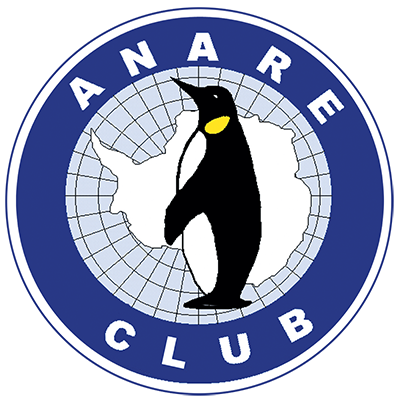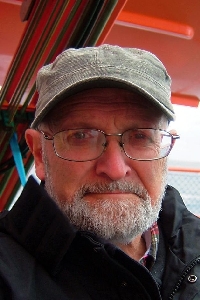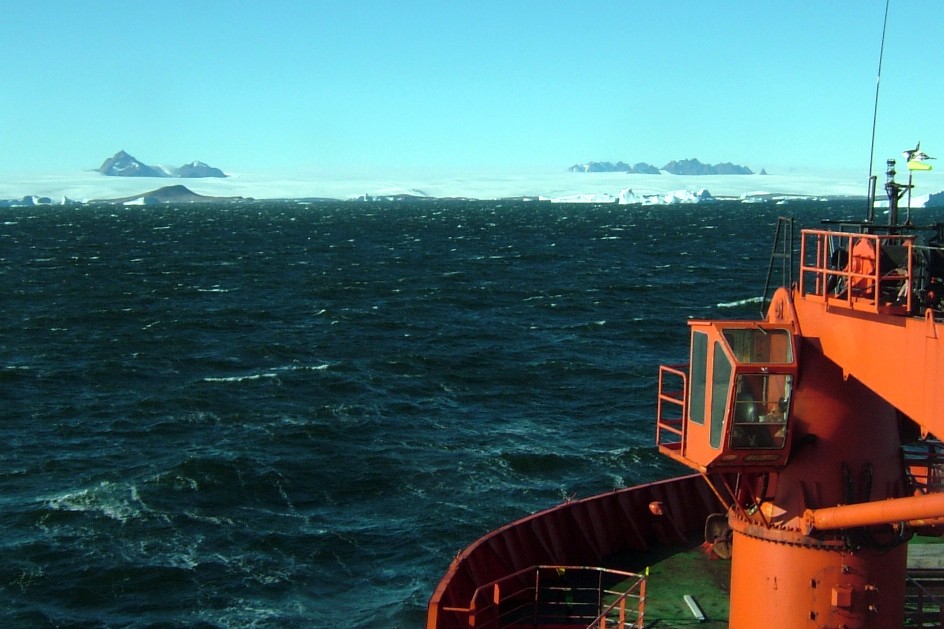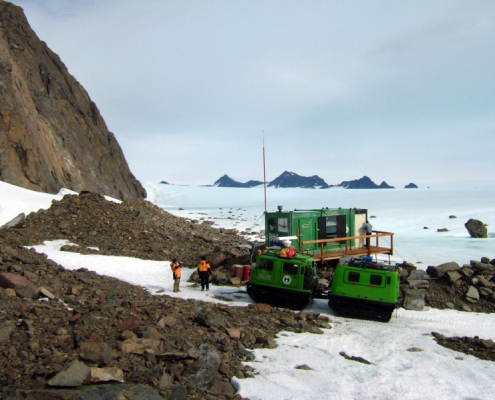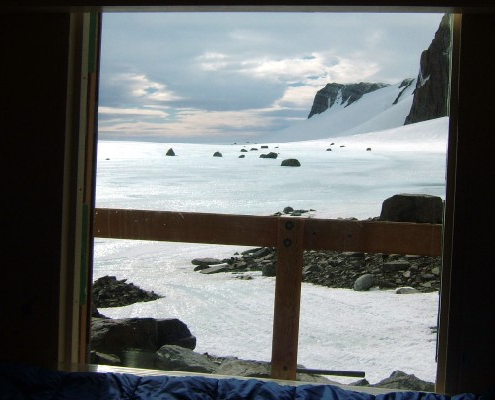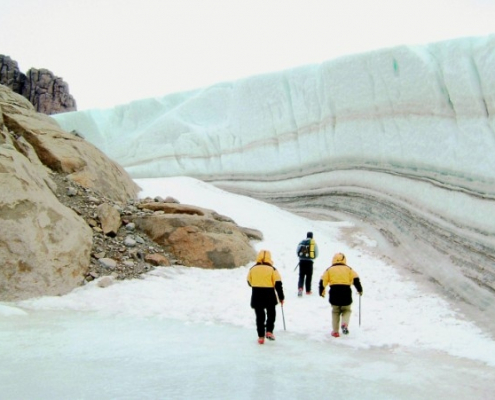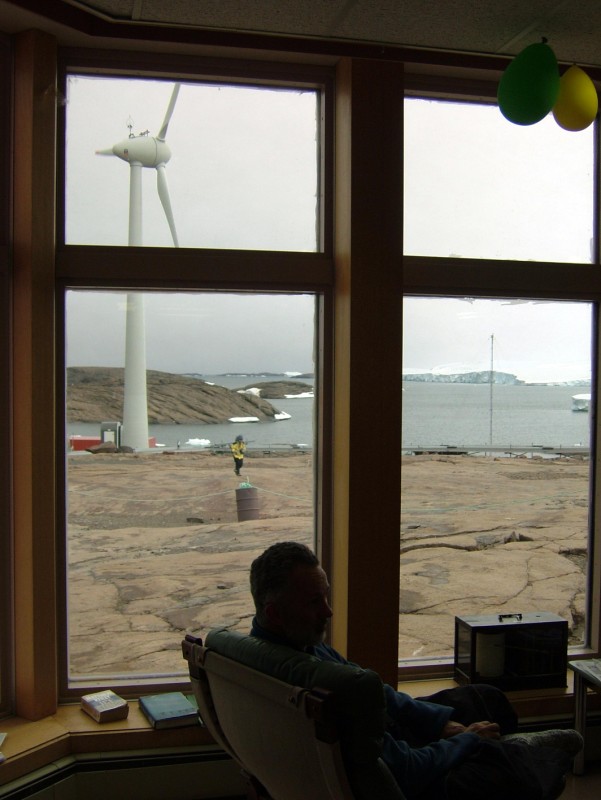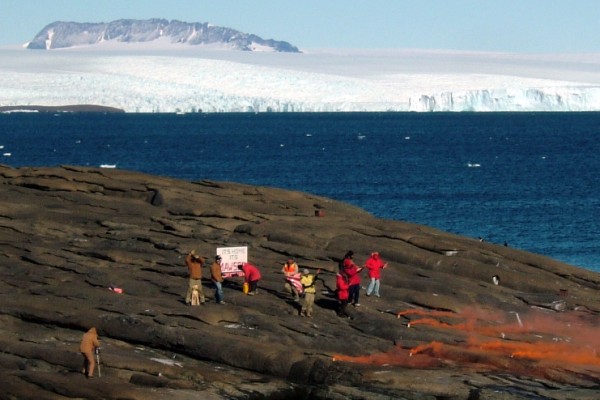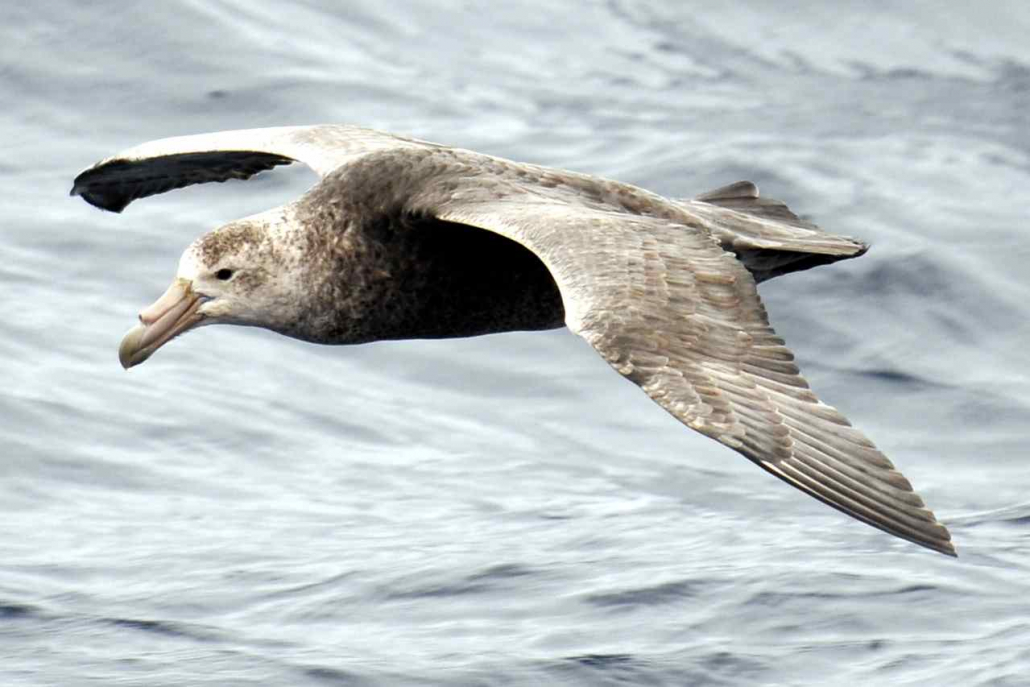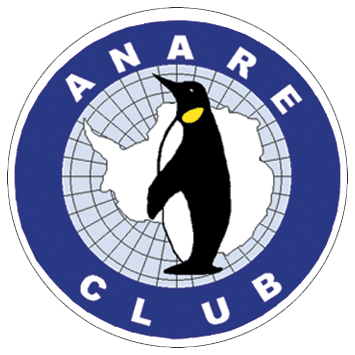PREPARATION 1
When I first travelled to Antarctica in 1988, the preparation was intense over a period of three months. All of us had come to grips with the technical demands which we would be facing in our various jobs, and the environmental challenges (and dangers) which were peculiar to Antarctica. It was exciting, demanding, and we were being paid for it!
This time I’m a guest of the AAD, and my only official job is to inform expeditioners of the benefits of joining the ANARE Club, flog club merchandise, and to help out wherever possible, both on the ship and (if I’m lucky) ashore at either Davis and/or Mawson. I’ve had three days in Hobart to sort out the details, and it’s been mostly social and always delightful. Friday was spent at “the Division” ostensibly to get kitted out with cold weather gear, most of which will be returned to the AAD after the voyage. But my presence at Kingston provided the opportunity to catch up with old friends from ’88 to’90, many of whom work in science and IT at the AAD. It seems that a passion for Antarctic matters turns into a career for many who have had a taste of that amazing place.
The social aspect included a delightful evening with five other expeditioners, two of them station leaders, one biologist and one Comms/IT specialist, and our hostess, Dr. Ingrid McGaughey. Having spent only one winter “on the ice”, I was the least experienced of them all! Between the six us, there were more than 15 winters spent at the various bases. The conversation ranged from the beneficial effects of tight restrictions on the consumption of alcohol, to the effects of high speed internet links which allowed the bureaucratic tentacles of Kingston to reach into the minutiae of station management.
A good bottle of shiraz prompted an animated discussion of the dysfunctional consequences of bureaucracy, and by the time we had all sounded off on this it was time to go home. Thanks, Ingrid – the “chicken magic” really was!
PREPARATION 2
Although the Aurora Australis was not scheduled to sail until 5pm, the day began with most passengers assembling at AAD headquarters at 11.30am for transport to the ship by bus. Two stops were made in downtown Hobart, then we proceeded directly to Macquarie wharf no. 4. There were no friends or relatives at the wharf – just security, customs and quarantine personnel. All farewells were made at bus stops – ship departures now seem to be as sterile as airport departures. My previous trip, 22 years ago, had families, sweethearts and friends in an enthusiastic crowd on the wharf, and many tears were shed and kisses blown as the “Icebird” pulled away. Not any more! This time the whistle blew, lines were cast off, the side thrusters started growling, and the “Orange Roughie” moved effortlessly out into the Derwent. Sideways! The technical smoothness of the operation was admirable, but the romance of maritime departures sank on September 11, 2001.
The process of getting from the bus and onto the ship was tightly controlled. Each item of personal baggage was weighed individually, to check that the total of 30kg per person was not exceeded. The bags were then stacked in metal cages for transfer by crane to the heli-deck at the rear of the ship. A formal inspection of the baggage was done by customs and quarantine officials, while the expeditioners, having walked unencumbered up the gangway, were subjected to a series of briefings on safety and survival at sea. This edifying experience climaxed with Australian Customs examining each expeditioner and his/her passport. I was ushered into the presence of a taciturn officer who took my passport,and looked at me as if I had just hopped off a plane from the Middle East. He then handed the document back to me, and I departed. Not a word was spoken by either of us during this entire transaction. The technical efficiency of the process was impressive, and the whole country has benefitted from the fact that this bloke didn’t pursue a career in the diplomatic service.
Within an hour we were on our way.
28 JAN 2010
This is our third day at sea, and this stubby but sturdy little ship explores every bump in the ocean. I am managing to maintain a delicate balance of inputs and outputs, but it ain’t easy! I lie down most of the time, take regular medications which are reasonably effective, and venture down to the mess for every meal. There I am faced with indomitable characters who eat like horses (I refer to quantity, not to the manner of eating). I, on the other hand, pick some morsel which looks nutritious and readily digestible, have a cup of weak tea, then, having eaten, retreat forthwith to my cabin for a little lie down. This procedure seems to work, but I’m not the life of the party! Our Voyage Leader, Rob Bryson, is very helpful with his SitReps They tell us how much worse things might have been had we not taken the long way around some low pressure system bearing down on us. There seems to be an unavoidable trade-off between the length of suffering and the intensity of suffering; a bit like life, really. So much for philosophy, I’m going to sign off and have a little lie down.
30 JAN 2010
There are about 40 passenger cabins on the ship, most of which contain four bunks. Each cabin has an en-suite bathroom, and a small desk plus four storage lockers. With only 41 passengers on this leg of the trip, we are spread out almost one to a cabin. Maximum capacity is about 106.
This will change at Davis and Mawson,where we will pick up many more passengers than we drop off. But the low numbers are particularly obvious at meal times, when less than half seem to show up, no doubt due to “mal de mer”.
Some regular “round trippers” have remarked that this one seems longer because there is little group social activity; a certain “critical mass” is needed to get things rolling (!). The theory is that you need a certain number of a certain personality type to have them “spark” off one another, then when sustained social fission is achieved, voila! – spontaneous outbreaks of people playing monopoly, scrabble and deck coits. Let’s see what happens on the trip back from Mawson. With the possibility of three hairy Mawson winterers in the same cabin, deck coits could be attractive!
Cheers Owen
Received Sunday evening 31 Jan 2010
Seas much quieter now – people emerging from hibernation – most of us have lost weight – Jenny Craig, eat your heart out!
I’m eating and not throwing up, maybe I’ll end up enjoying this shipboard life.
1 FEB 2010
It’s Sunday afternoon, most have recovered from their sea-sickness, and the prospect of a Trivia Night after dinner will probably induce the troglodytes out of their caves. This could be our first big social “bash”. The other item which is raising spirits is the promise of sticky date pudding, for which the chef is justly famous. Since so many of us have lost weight over the last week, we can confidently get stuck into a good desert with impugnity. It’s also comforting to know that those who didn’t get sea-sick will soon be racked by guilt!
But the news that next week’s flight of the A319 has been cancelled because of weather conditions at Casey brings back memories of the very first flight from Tasmania to Antarctica in November of 1988. I had only been on Casey station for less than a month, when nearly all of the station crew were transported in various vehicles up to S1 (an old glaciology site about 5km from Casey) early one morning. There was little cloud cover, and the sight of pink icebergs on a dark blue sea was breathtaking.
We had been waiting for no more than half an hour when VHF contact was made with the Twin Otter aircraft being flown by Dick Smith and renowned British polar aviator Giles Kershaw. They had come all the way from Hobart, with the aid of additional fuel stored in bladders in the passenger cabin. A primitive runway had been prepared by Casey staff, simply by dragging steel girders over the surface with bulldozers. By angling the girders appropriately, snow had been pushed to the sides over a distance of at least 500m, with a runway width of no more than 20m. When the plane came into view, it first made a low pass over the “facilities”, then went around again for a landing. It was an impressive sight to see that plane coming in with flaps down and landing lights on. It touched down gently, braked with reverse pitch on the two propellers, and stopped within a few hundred metres. It then did a U-turn, and slowly returned to a spot adjacent to the welcoming party.
As the turbine engines wound down, a window on the flight deck opened, and there was the smiling face of the “Electronic Dick” (as his company trucks loudly proclaimed). In due course, the side door with integral staircase opened, and out stepped the two intrepid flyers. The welcoming party was led by our Station Leader, the indomitable Tom Maggs. Tom was just starting to wax lyrical about the staggering importance of the event, when there darted out from among the assembled multitude two St. Trinnians schoolgirls, with blond wigs, fulsome blouses, short blue tunics, frilly knickers and fishnet stockings. They skipped straight past the official party, and presented the startled airmen with bunches of plastic flowers and kisses on both cheeks. The two interlopers then dashed back into the crowd to put on warm clothes, before anything that girls don’t have dropped off.
Tom, ever the pragmatist, realised that he had no chance of restoring that sense of decorum which is so characteristic of ANARE ceremonies, and dispensed with further formalities. After checking and securing the aircraft, the party moved back down the hill to Casey, where Dick and Giles stayed for several days as official guests of the AAD. Later that summer the Twin Otter and its enterprising crew provided valuable logistic support to Australian antarctic operations.
There are two important footnotes to this story :
1.Several years after the Dick Smith flight, Giles Kershaw, a highly experienced pilot, lost his life while flying an experimental aircraft.
2.One of the two “girls” mentioned above went on to do great work for the AAD over several decades; his contribution has been formally acknowledged. However, defamation laws prevent me from naming this fellow, who was the main conspirator in this disgusting and reprehensible fiasco.
4 FEB 2010
Yesterday was full of pomp and ceremony – Aussie style. King Neptune and his entourage of sycophantic sadists visited us around 3pm, and those passengers and crew who had not previously crossed the Antarctic Convergence (where sea temp suddenly drops) were subjected to processes which I thought had been banned by the Geneva Convention. The hilarity was universal – even the victims said that they enjoyed it!
Then, after giving the initiated ones time to clean up, a BBQ was held on the trawl deck at 5.30pm. This ritual seems to have become a standard feature of ANARE voyages. On the Icebird in ’88 the German crew thought we were all crazy to stand around in the freezing out-doors, drinking beer and eating the burnt offerings coming from a slightly modified incinerator.
Today was different – the beer ration was determined by the Voyage Leader (it’s a dry ship), and the barbecue was a purposely built version reflecting Australian ingenuity and design flair. It’s amazing what can be done with a 44 gallon drum! The food was consistent with the AA’s high standards, and the jovial mingling of passengers and crew was delightful.
8 FEB 2010
The first impression of Davis is that the station was not laid out by Walter Burley Griffin. Perched on a peninsular, this triumph of building technology over aesthetics houses a community of workers whose hospitality has no bounds. Station Leader Mike Woolridge and his people went to great lengths make us welcome; their efforts were much appreciated by those of us who had the good fortune to get ashore.
We “round trippers” were piggy-backed onto various modes of transport which were carrying scientists into the field, and which had spare seats. Executing these complex operations kept the comms, helicopter and small boat people busy, but it all seemed to work smoothly. Sleeping in the small hut at Platcha was an unforgettable experience, and I’m well on the way to recovery. Many thanks to FTO Mike Grimmer.
The summer accommodation problem, common to all stations, is that the numbers present in summer can be four times those present in winter. Apart from providing sleeping facilities for all these extras, heavy additional loads are placed on all the supporting services, not to mention the longer term residents who have to keep the whole show going. The frenetic summer programme in science and construction adds to the stresses on the station, and those staying for the winter heave a sigh of relief when the last ship departs, leaving them in peace.
When the last barge left Davis, bound for the AA, the waving mob on the wharf were almost jubilant ; were they glad to see us go? This bodes well for the feelings which will accompany the departure of the final ship (for this season) in March.
“Parting is such sweet sorrow” Romeo and Juliet, Act 2, Scene 2
10 FEB 2010
The absence of sea-ice in front of the Amery Ice Shelf has allowed the AA to cut straight across to Mawson, without going hundreds of km north. We did the trip in 33 hours, only to be frustrated by strong off-shore katabatic winds on arrival. Being only 10km from the shore, we had a clear view of many rarely seen land forms along the Christensen Coast.
Foremost among these was the Scullin Monolith, which one excited old timer said he didn’t expect to see in his lifetime. I didn’t enquire as to whether this was a reflection on his life expectancy or the improbability of the sighting.
It’s Wednesday, and we are still waiting for the winds to drop so that we can get into Horseshoe Harbour. Few people are showing up for meals. For those who left Davis, the whole Mawson exercise is an irritating delay – they just want to get back to Hobart. There is definitely a post-Davis lethargy abroad; then, maybe it’s a pre-Mawson frustration. Maybe it’s seeing the same iceberg go past the porthole repeatedly.
There is only one cure – go up onto the bridge and gaze at the Masson Range and Mount Henderson, poking through the ice-cap just behind the station. The view is simply magnificent. I’m off !
Looking from AA towards Mawson; Mt Henderson on the left, Masson Range on the right
14 FEB 2010
The above words have nothing to do with giving chocolates to your mother-in-law. They are intended to describe the innovative work being done at Mawson to increase energy efficiency and reduce the consumption of fossil fuels and attendant CO2 emissions. The most conspicuous hardware in this enterprise consists of two wind turbines, each capable of generating 300 kW of electrical power.The centres of rotation are 30 m off the ground; each of the six blades is 15m long. There is no gearbox – the rotating hub drives a multi-pole alternator directly. It’s amazing to think that cold, dense air, sliding down off the ice cap, could easily drive 6,000 electric blankets! And only 14 expeditioners are staying for this winter! Are those people in Kingston crazy? No way! To substitute for 5,986 electric blankets (conspicuously missing from the AA re-supply cargo) they have installed an espresso coffee machine,the most important electrically powered flash boiler and drug dispensing apparatus on the station. Despite having received no formal training in the operation of this device, old-time residents of the station can produce great coffee. The OH&S implications of this lack of formal accreditation procedures are disturbing, and inconsistent with the policies in force for all motor vehicles, cranes, boats, staplers and pencil sharpeners.
17 FEB 2010
Energy systems management is the big deal on Mawson. With about 500kw available from the main diesel generating plant, and 600kw available from the wind turbines under optimal wind conditions, the big problem is to maximise energy delivered by the emissions-free sources, while minimising fossil fuel consumption. This is a tricky juggling act. Diesel engines/generators (there are 4 putting out about 130kw each) like to be run near full load, and they don’t like to be stopped and re-started often. And the waste heat from the engines’ coolant is piped around the station for building heating. But the power being delivered by the wind turbines is highly variable. Furthermore, the electrical load imposed by devices on the station is not constant. Are you confused? So are the control systems which attempt to keep this system stable!
When wind turbines are employed on big national grids, their output has practically no influence on the grid’s voltage or frequency. But in situations like the one at Mawson (or any relatively small, isolated system), power surges can be a serious problem. Especially when there are sudden increases in electrical load, caused by the turning on of heaters, pumps, or ovens in the kitchen. Blackouts are not unknown at Mawson – last year one power interruption reset the timers in an oven, and a birthday cake was turned into a nutritious frisbee. No doubt there are more serious problems arising from such interruptions.
Electrical engineer David Waterhouse has been looking after these matters for the past year. This demanding job for the coming winter has been taken over by Ruth Wielinga, whose professional skills will be brought to bear on these novel problems. Ruth mentioned, at a social gathering, that she was chasing a strange cyclic load on the system. Someone or something was pulling power from the system, increasing steadily to 40kw. Then it dropped suddenly, before repeating the cycle. I suggested that it was probably a perverse expeditioner with 20 fan heaters, who plugged more and more of them in until a circuit breaker tripped somewhere. She then unplugged all the heaters, reset the breaker, and repeated the cycle. This was the Mawson joule thief! Ruth remained silent, took a deep breath, and poured herself another drink.
18 FEB 2010
One of the first things which people want to do when they get onto a station is to get off it – on a field trip. FTO (field training officer) Nick Morgan took three of us “round trippers” out to “Rum Doodle” hut in the Masson Range. It’s a 20km run in a Hagglunds vehicle, which is as durable as a canvas handkerchief and almost as comfortable. The trip was mostly over blue, windswept ice, and the hut and its surroundings were impressive (I’m running out of adjectives). Then came the walk. For two hours Nick took us on a stroll through wind-scoured gullies, across frozen lakes, between towering jagged hills. This is the country which makes Mawson unique among the Australian stations. It was a great feeling to be among those mountains which we could see a week earlier from the ship. For all three of us, this was the highlight of the whole 6 week adventure.
On the station, work was frenetic. Over 400,000 litres of fuel was pumped ashore, and several hundred tons of supplies were transferred by barge. Station Leader Mike “Duk” Craven went to great lengths to ensure that all the ship’s passengers had at least one night ashore; most of the ship’s crew managed to get “onto the ice”, too. All round, it was considered a very successful re-supply operation, and the whole voyage is nearly a week ahead of schedule.
I know it reveals an unconventional order of priorities, but my strongest memory of Mawson is the food. Chef Maria Tomasi makes a pasta to die for! If I spent a winter on Mawson, I would certainly emerge a very round tripper!
23 FEB 2010
Much science must remain a “hands on” business, in that the gathering and studying of specimens is labour intensive. Biologists, zoologists, glaciologists, oceanographers and physicists now have ready access to colleagues and a vast knowledge base via the internet; this is of enormous help in exploiting unforseen opportunities.
Even in remote field locations, scientists can use Iridium satellite phones to dial straight into the global phone network. The ability to exchange text messages, photos, and data from sensors means that the scientist in Antarctica can remain a part of the world-wide scientific community. Isolation has gone.
The instrumentation used in space physics, geophysics and meteorology has also changed. Once equipment is set up, data links via satellite eliminate the need for any people to operate it. The old days of chart recorders, film development, and marginal equipment design are over. Standardised hardware and standarised data communications protocols have allowed widespread use of unattended equipment. Twenty years ago, UAP (Upper Atmosphere Physics) had four physicists and two support engineers (I was one) spread across the three stations. Now there is one physicist only, at Davis, with more experiments running than ever, and data is sent continuously via satellite to Kingston. Much of it goes straight to websites where it can be viewed from anywhere by anyone in real time. Provided, of course, that they are affluent enough to have access to a computer and the internet.
Biologists Luke Einoder and Daren Southwell have just returned from a 6 week sojourn on an island close to Mawson. Here is Luke’s description of their work:
“A long term study of Adelie penguins at Bechervaise Island near Mawson is one example of the logistical advantages of remote sensing equipment in the field of biology. Some years ago a low fence was constructed around apart of the penguin colony forcing birds to travel over a weighbridge as they come and go from the sea. At the weighbridge are two antennas that are responsive to small glass encapsulated microchip tags. These tags, similar to those used on domestic pets, have been implanted in many penguins from the colony and identify individuals. The two antennas determine which direction an individual is travelling, so the weight of the bird upon arrival and departure is recorded. All data can be downloaded via satellite in Kingston to allow calculations of the weight of food delivered to chicks through the season, and over numerous years. All this contributes to our understanding of the feeding conditions the penguins experience in the ocean at any given time, and provides an indirect indication of the health state of the chicks in the colony, and the variation in conditions from year to year”.
While this technology may not have been readily applied to elephant seals (just try to fence them in!), maybe the AAD could licence the intellectual property to restaurants, gymnasiums and porta-loo contractors. Anyone for a chip implant? Civil libertarians need not apply.
Mawson – view from the lounge
25 FEB 2010
It’s a long way from Mawson to Hobart. It can take up to a fortnight, depending on weather. The journey started for us with smooth seas and many icebergs north of the Amery Ice Shelf. These spectacular views were interspersed with occasional sightings of whales, orcas, and majestic albatrosses. Such sightings are often announced on the PA system, resulting in a scramble of keen photographers up onto the bridge. Impeding the climb of each of these enthusiasts is invariably a digital SLR camera, with at least 12 mega-pixels of resolution, and a zoom/telephoto lens the size of two house-bricks (end to end). Sometimes, when I am swept away in these waves of enthusiasm, I lower the tone of the whole occasion by producing a 7 M-pixel pocket camera, which is regarded with barely concealed disdain by others on the bridge. On several occasions I have had the temerity to produce my classic Rollei B35 film camera, leaving the impression that I have either serious techno-phobia or early onset dementia. However, many of these very competent photographers generously put their photos on the ship’s file server, for all to see. Nearly everybody seems to have a laptop PC with wireless networking facilities, and all can exchange photos readily.
Rob Bryson, Voyage Leader, has announced that Saturday evening will be “special”, with a barbecue on the helideck, and alcoholic beverages provided. The AA should be close to Tasmania by then, and we can all look forward to enjoying Tasmanian weather, rather than Antarctic weather, regardless of the claim by some (from the north island) that there isn’t much difference. As someone who’s been snowed on twice on mid-summer bushwalks, once in the Walls of Jerusalem and once on the Mt. Anne circuit, I intend to be fully dressed for the occasion. At least on the helideck, regardless of Tasmania’s proximity, there will be no mud!
CORRECTION : NO BBQ ON HELIDECK, OR TRAWL DECK, OR HOLODECK (for “Trekkies”) OR ANYWHERE. Just drinks in the bar at 1900. I’m confused – time to go home!
Giant Petrel photo Zina Sofer
Sunday began early, especially for those of us who had disturbed sleep patterns for the last few nights. The plan was to get all our luggage onto the helideck by 0630, so most were up and abouby 0600. Then ,over the PA system, came the dulcet tones of Rob Bryson, informing us that a tsunami warning had been issued for the east coast of Australia. A four hour delay in the day’s operations would result. My first reaction was to check that the date was not April 1 (Rob does have a warped sense of humour), but as the implications dawned on the stunned listeners, a flurry of frantic phone calls resulted. Friends and relatives had to be informed, and transport arrangements changed.
The day which started with a rush suddenly collapsed in boredom. Eventually, luggage was left on the helideck for inspection by quarantine officers; it was then loaded into cage pallets for transport by crane to the wharf. Finally, we were all checked out by Customs and as a single group in single file, we were led onto the gangway. In front was the conspicuous Jeremy Wills, in business suit,
baseball cap and sunglasses, followed by about 40 others variously attired. Despite the intimidating appearance of this unruly mob, the Customs officers remained calm even though they were unarmed! We were led across the wharf and alongside tall security fences, with regular exhortations from the uniformed ones that we should not stray from the single line. In a few minutes we were “out”, among smiling, welcoming faces. I was reminded of the time I came through Checkpoint Charlie into West Berlin before the wall fell!
The reception was great! A “trad” jazz band was in full swing, light refreshments were available, and AAD staff were present to finalise paperwork and offer help wherever needed. Eventually, AAD Director Lyn Maddock started the formal presentation of certificates to the expeditioners. I was comforted by the knowledge that if this ceremony had been held at the time originally planned, the party might have been gatecrashed by the Aurora Australis! But it all went smoothly, people collected their luggage, and the crowd dispersed. Voyage 3 was over.
ACKNOWLEDGEMENTS :
I would like to thank the Australian Antarctic Division and its Director, Lyn Maddock, for their generous provision of a berth for the ANARE Club on Voyage 3. Thanks also to the Executive of the Club for choosing me as their representative. Lastly, thanks to Col Christiansen for maintaining this website, and putting some structure into my incoherent ravings.
